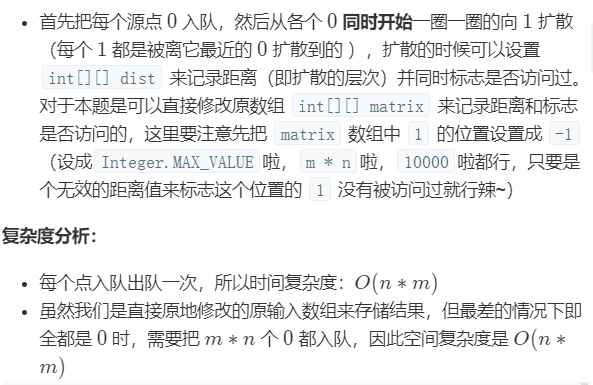有大致的思路,想到的方法类似于动态规划,但是写不出代码来
也没想到用队列来做。
看了高分评论:

方法一:

class Solution { public int[][] updateMatrix(int[][] matrix) { // 首先将所有的 0 都入队,并且将 1 的位置设置成 -1,表示该位置是 未被访问过的 1 Queue<int[]> queue = new LinkedList<>(); int m = matrix.length, n = matrix[0].length; for (int i = 0; i < m; i++) { for (int j = 0; j < n; j++) { if (matrix[i][j] == 0) { queue.offer(new int[] {i, j}); } else { matrix[i][j] = -1; } } } int[] dx = new int[] {-1, 1, 0, 0}; int[] dy = new int[] {0, 0, -1, 1}; while (!queue.isEmpty()) { int[] point = queue.poll(); int x = point[0], y = point[1]; for (int i = 0; i < 4; i++) { int newX = x + dx[i]; int newY = y + dy[i]; // 如果四邻域的点是 -1,表示这个点是未被访问过的 1 // 所以这个点到 0 的距离就可以更新成 matrix[x][y] + 1。 if (newX >= 0 && newX < m && newY >= 0 && newY < n && matrix[newX][newY] == -1) { matrix[newX][newY] = matrix[x][y] + 1; queue.offer(new int[] {newX, newY}); } } } return matrix; } }
方法二:

class Solution { public int[][] updateMatrix(int[][] matrix) { // 首先将 0 边上的 1 入队 int[] dx = new int[] {-1, 1, 0, 0}; int[] dy = new int[] {0, 0, -1, 1}; Queue<int[]> queue = new LinkedList<>(); int m = matrix.length, n = matrix[0].length; int[][] res = new int[m][n]; for (int i = 0; i < m; i++) { for (int j = 0; j < n; j++) { if (matrix[i][j] == 0) { for (int k = 0; k < 4; k++) { int x = i + dx[k]; int y = j + dy[k]; if (x >= 0 && x < m && y >= 0 && y < n && matrix[x][y] == 1 && res[x][y] == 0) { // 这是在 0 边上的1。需要加上 res[x][y] == 0 的判断防止重复入队 res[x][y] = 1; queue.offer(new int[] {x, y}); } } } } } while (!queue.isEmpty()) { int[] point = queue.poll(); int x = point[0], y = point[1]; for (int i = 0; i < 4; i++) { int newX = x + dx[i]; int newY = y + dy[i]; if (newX >= 0 && newX < m && newY >= 0 && newY < n && matrix[newX][newY] == 1 && res[newX][newY] == 0) { res[newX][newY] = res[x][y] + 1; queue.offer(new int[] {newX, newY}); } } } return res; } }
动态规划方法需要再看看!!!